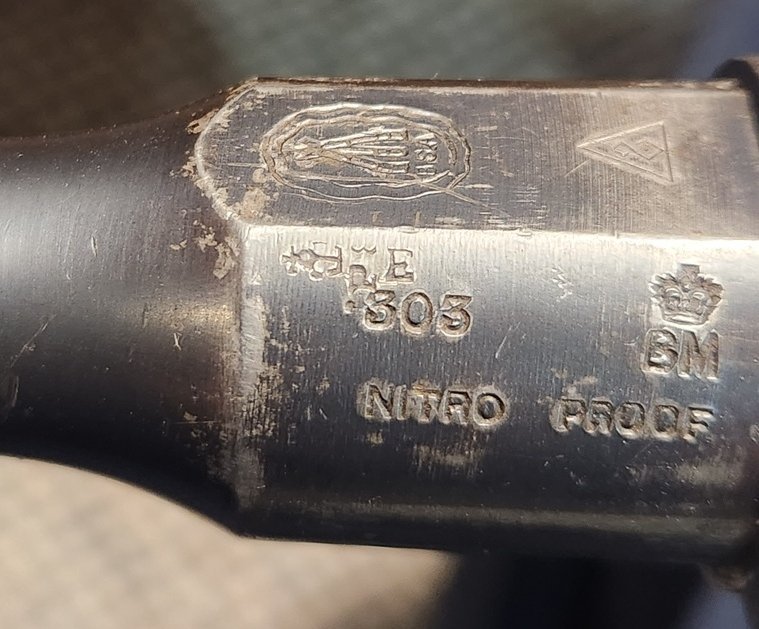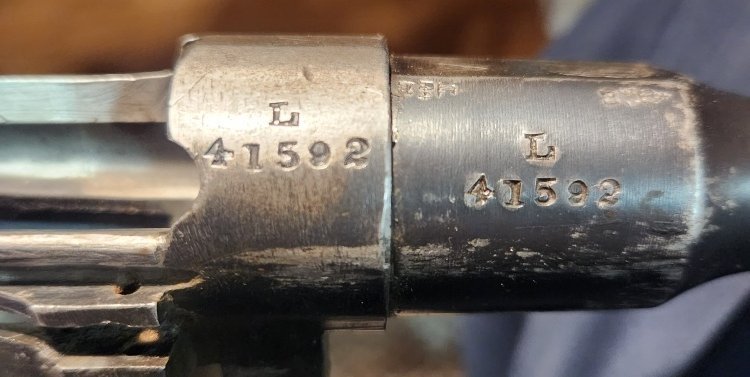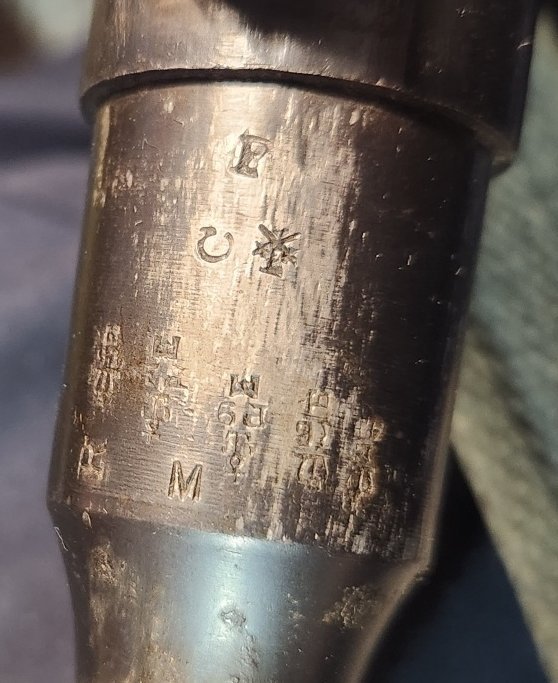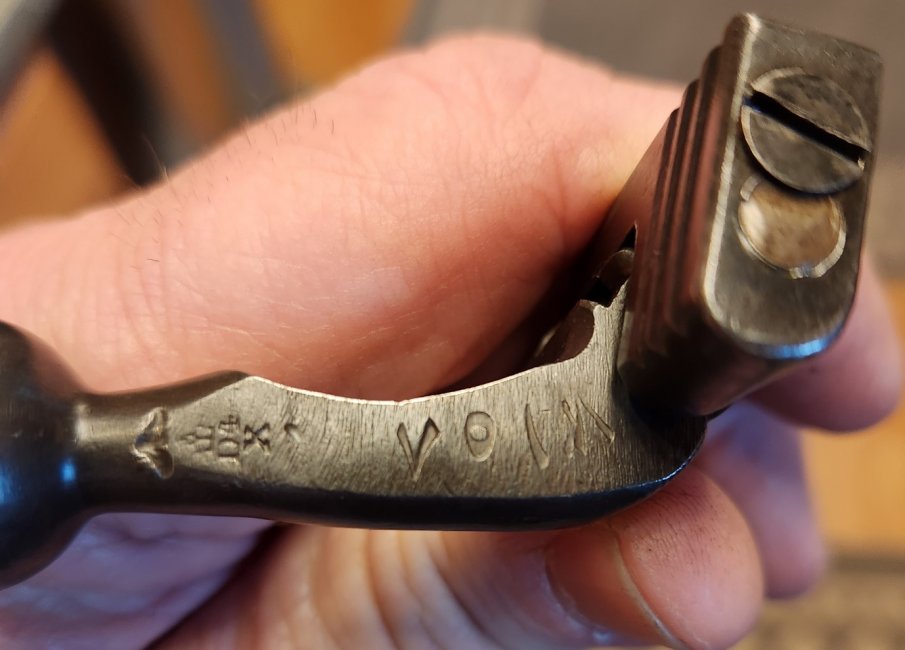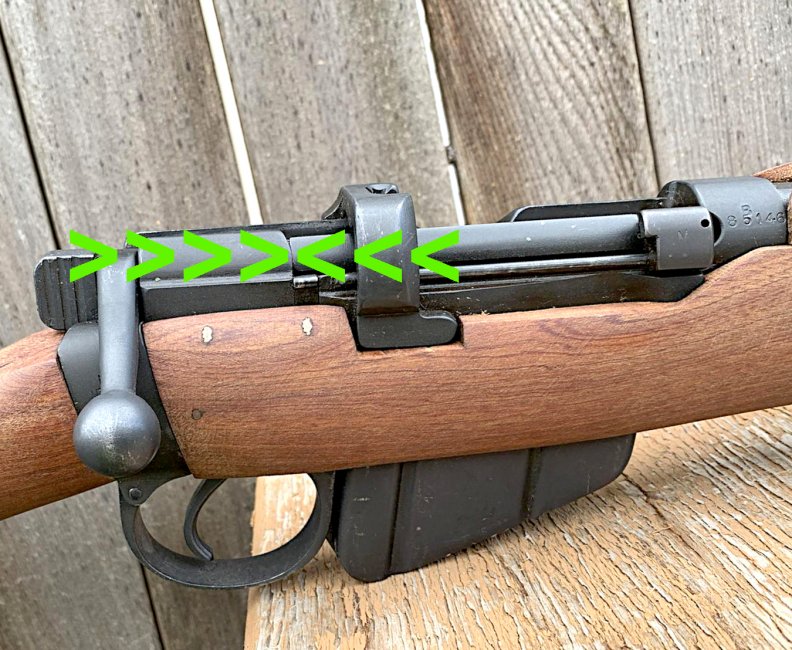You are using an out of date browser. It may not display this or other websites correctly.
You should upgrade or use an alternative browser.
You should upgrade or use an alternative browser.
New to me SMLE
- Thread starter trailtoy
- Start date
The #1 community for Gun Owners of the Northeast
Member Benefits:
No ad networks! Discuss all aspects of firearm ownership Discuss anti-gun legislation Buy, sell, and trade in the classified section Chat with Local gun shops, ranges, trainers & other businesses Discover free outdoor shooting areas View up to date on firearm-related events Share photos & video with other members ...and so much more!
Member Benefits:
The HV behind the back site means High Velocity/Short cone
Looks Middle east or from Iraq. Aarbi marks on butt stock disc.
If you flip it over it may have something on the obverse.
The Gr is George Rex Cypher
No * on wrist socket. It also looks to be milled for a mag cut off but not sure.
The other reinforce markings are view /proof and inspection marks.
If the number on the bolt matches the one on the body you should be good to go for shooting.
When you pull the forestock off it, make sure its driven downwards at the rear on either side of the action just in front of the wrist socket or it will damage the draws.
Also make sure you remove the forestock if you choose to turn the butt stock bolt out.
The front of the bolt has a square protrusion on it that projects into the tie plate at the rear of the forestock.
Turning it will split the forestock possibly with too much applied force because the bolt is meant to interface with the tie plate so it doesn't turn loose.
With the stocks turned up correctly it would be a great shooter combined with good ammo and hold for sure.
Theirs also a tension screw and plunger arrangement in the fore stock that dampens barrel vibrations.
It will look like a vee shaped cup or plunger that sits at either side of the barrel and rest against the bottom because of the minimum pencil weight or lite barrel engineered into the rifle system.
Looks Middle east or from Iraq. Aarbi marks on butt stock disc.
If you flip it over it may have something on the obverse.
The Gr is George Rex Cypher
No * on wrist socket. It also looks to be milled for a mag cut off but not sure.
The other reinforce markings are view /proof and inspection marks.
If the number on the bolt matches the one on the body you should be good to go for shooting.
When you pull the forestock off it, make sure its driven downwards at the rear on either side of the action just in front of the wrist socket or it will damage the draws.
Also make sure you remove the forestock if you choose to turn the butt stock bolt out.
The front of the bolt has a square protrusion on it that projects into the tie plate at the rear of the forestock.
Turning it will split the forestock possibly with too much applied force because the bolt is meant to interface with the tie plate so it doesn't turn loose.
With the stocks turned up correctly it would be a great shooter combined with good ammo and hold for sure.
Theirs also a tension screw and plunger arrangement in the fore stock that dampens barrel vibrations.
It will look like a vee shaped cup or plunger that sits at either side of the barrel and rest against the bottom because of the minimum pencil weight or lite barrel engineered into the rifle system.
ken792
Ultimate Member
It’s an Iraqi contract/purchase. Those marks enclosed in triangles are Iraqi property marks. Some say that the contract was completed in 1937, but there are 1938 and 1939 dated examples out there.
Nice catch on the lack of *, I didn't notice until I read that. Wondering why they were making Mark IIIs in 1938 but I guess it was a middle east contract and they may have had left over Mark III actions from the war. Definitely looks set up for a cut off as well. A year before the war started I thought they were gearing up to start #4s.The HV behind the back site means High Velocity/Short cone
Looks Middle east or from Iraq. Aarbi marks on butt stock disc.
If you flip it over it may have something on the obverse.
The Gr is George Rex Cypher
No * on wrist socket. It also looks to be milled for a mag cut off but not sure.
The other reinforce markings are view /proof and inspection marks.
If the number on the bolt matches the one on the body you should be good to go for shooting.
When you pull the forestock off it, make sure its driven downwards at the rear on either side of the action just in front of the wrist socket or it will damage the draws.
Also make sure you remove the forestock if you choose to turn the butt stock bolt out.
The front of the bolt has a square protrusion on it that projects into the tie plate at the rear of the forestock.
Turning it will split the forestock possibly with too much applied force because the bolt is meant to interface with the tie plate so it doesn't turn loose.
With the stocks turned up correctly it would be a great shooter combined with good ammo and hold for sure.
Theirs also a tension screw and plunger arrangement in the fore stock that dampens barrel vibrations.
It will look like a vee shaped cup or plunger that sits at either side of the barrel and rest against the bottom because of the minimum pencil weight or lite barrel engineered into the rifle system.
Any way nice #1 OP.
ken792
Ultimate Member
No. 4 serial production didn’t start until 1941. BSA actually kept making the SMLE for most of WWII, even as No. 4 production took off. From what I read, BSA having to call back retired employees to help set up the Iraqi contract happened to make them ready to make the SMLEs for the British during WWII. BSA was damaged by German bombing and dispersed its SMLE production to smaller facilities, which collectors call dispersal rifles.Nice catch on the lack of *, I didn't notice until I read that. Wondering why they were making Mark IIIs in 1938 but I guess it was a middle east contract and they may have had left over Mark III actions from the war. Definitely looks set up for a cut off as well. A year before the war started I thought they were gearing up to start #4s.
Any way nice #1 OP.
Managed to shag a dispersal some time ago, and know the Brits were desperate then as they lost quite a bit at Dunkirk, but I thought the # 4 was/would have been in development stage well before they started production. Still kinda surprised it is a Mark III with no *.No. 4 serial production didn’t start until 1941. BSA actually kept making the SMLE for most of WWII, even as No. 4 production took off. From what I read, BSA having to call back retired employees to help set up the Iraqi contract happened to make them ready to make the SMLEs for the British during WWII. BSA was damaged by German bombing and dispersed its SMLE production to smaller facilities, which collectors call dispersal rifles.
BFMIN
Ultimate Member
The number under the handle is an "assembly number" designed to keep the bolt & receiver "matched" during its trip through the factory. The actual serial number, which should be matching the receiver & barrel number is on the rear face, as has been mentioned.
If you look carefully at the rear face you may be able to see where its been re-ground? There should also be a "Crossed Seaxes" poof mark (looks like little triangular flags) This is frequently ground off if a bolt is mismatched. (top bolt) Which has been re-fitted for headspace, locking lug engagement & firing pin protrusion & then renumbered to match..
If you look carefully at the rear face you may be able to see where its been re-ground? There should also be a "Crossed Seaxes" poof mark (looks like little triangular flags) This is frequently ground off if a bolt is mismatched. (top bolt) Which has been re-fitted for headspace, locking lug engagement & firing pin protrusion & then renumbered to match..
Attachments
mawkie
C&R Whisperer
Nice find! It's been a while since I've seen an Iraq Contract example. They don't pop up on the market all that much these days with most tucked away deep in collections. Probably the only SMLE I didn't have in my collection.
Just sent my BSA dispersal off to auction which broke my heart, considering how long it took to acquire. But you can't keep 'em forever.
Just sent my BSA dispersal off to auction which broke my heart, considering how long it took to acquire. But you can't keep 'em forever.
I wonder what # it is?
Maybe someone here could say.
At any rate, because that’s a nice rifle it would be worthwhile to understand how the lug contact is,regardless of the number.
You can smoke the lugs with a birthday candle if you have one handy and check the engagement surfaces to get a good idea.
You’ll not see 100% engagement because that’s where primary extraction originates. The surfaces are irregularly shaped.
A dummy cartridge will help to give even bearing if you decide to check it out.
Maybe someone here could say.
At any rate, because that’s a nice rifle it would be worthwhile to understand how the lug contact is,regardless of the number.
You can smoke the lugs with a birthday candle if you have one handy and check the engagement surfaces to get a good idea.
You’ll not see 100% engagement because that’s where primary extraction originates. The surfaces are irregularly shaped.
A dummy cartridge will help to give even bearing if you decide to check it out.
7158I wonder what # it is?
ken792
Ultimate Member
That’s only to check lug bearing so one lug doesn’t bear all the force of firing.The number is 7158. I will try the smoke trick and see what it says. Is that a good indicator of headspace or should I get that checked as well? I like that they left the original proof stamps on it.
There’s a ghetto way to check headspace by taking a sized case or live round (at a range or other safe location), measuring the thickness of the rim, and either putting shim stock behind the case until resistance is felt closing the bolt or closing the bolt with a little bit of lead or solder. The headspace range is fairly generous on them anyway with the 0.080” War Spec.
Edited to correct number
Last edited:
I’ve heard of .078 expedient contingencies but never .084, whether that’s a typo or can be located in the armorers instructions I’m not sure.
But anyway here’s why that’s important,
Differing lots of ammunition are not always created with the same exact rim thickness.
And because of this, when you get out to the limits of any rimmed cartridge what begins to happen is that when the rim is not entirely supported at the breech, the cartridge as a whole droops in the chamber which drastically effects accuracy as well as promotes safety concerns for avoiding a head separation. The good news is that rimmed cartridges being a superior design than rimless cartridges in that regard for strength seals the end of the chamber to control unregulated gas expansion just by the very nature of the case and head construction alone.
The bad news for a SMLE is that if headspace is greater than .074, the bolt heads are not interchangeable in that they can be selected for length so a user may have to pick up a few bolt heads to find one that does not overlock and has not been adjusted for a rifle that had a minus condition.
The positives are, is that a British SMLe probably has more R&d into the rifle and ammo construction and the combined development of the two with quality checks than any other period combat rifle up to and including the present day.
But anyway here’s why that’s important,
Differing lots of ammunition are not always created with the same exact rim thickness.
And because of this, when you get out to the limits of any rimmed cartridge what begins to happen is that when the rim is not entirely supported at the breech, the cartridge as a whole droops in the chamber which drastically effects accuracy as well as promotes safety concerns for avoiding a head separation. The good news is that rimmed cartridges being a superior design than rimless cartridges in that regard for strength seals the end of the chamber to control unregulated gas expansion just by the very nature of the case and head construction alone.
The bad news for a SMLE is that if headspace is greater than .074, the bolt heads are not interchangeable in that they can be selected for length so a user may have to pick up a few bolt heads to find one that does not overlock and has not been adjusted for a rifle that had a minus condition.
The positives are, is that a British SMLe probably has more R&d into the rifle and ammo construction and the combined development of the two with quality checks than any other period combat rifle up to and including the present day.
ken792
Ultimate Member
Whoops, meant to write 0.080.” There was a wartime notice of that for No. 1s only.I’ve heard of .078 expedient contingencies but never .084, whether that’s a typo or can be located in the armorers instructions I’m not sure.
BFMIN
Ultimate Member
Actually there's an easier H/S substitute test if you're happy with that methodology.
Chamber a resized, but not reloaded yet case. Partially close the bolt & slip a feeler gauge in between the right side locking lug front of the receiver & the back of the bolt's matching locking lug (The Rib). Try to close the bolt on it. DON'T Gorilla it! Just one finger pressure on the bolt knob. The first gauge that does NOT allow closing plus the rim thickness is the approximate headspace.
Chamber a resized, but not reloaded yet case. Partially close the bolt & slip a feeler gauge in between the right side locking lug front of the receiver & the back of the bolt's matching locking lug (The Rib). Try to close the bolt on it. DON'T Gorilla it! Just one finger pressure on the bolt knob. The first gauge that does NOT allow closing plus the rim thickness is the approximate headspace.
Attachments
Yes at any rate the main concern would be for not to have an inoperable rifle for when its needed the most by not getting having to get a broken shell extractor out.
I dont think the OP need worry himself over every small detail in that regard.
He's got a pretty nice looking example there to begin with and based on what Ive seen so far I wouldn't worry about shooting it the least bit to see what effects it produces.
I dont think the OP need worry himself over every small detail in that regard.
He's got a pretty nice looking example there to begin with and based on what Ive seen so far I wouldn't worry about shooting it the least bit to see what effects it produces.
Yes thats it, soon as it touches stop right there and you'll have it.Actually there's an easier H/S substitute test if you're happy with that methodology.
Chamber a resized, but not reloaded yet case. Partially close the bolt & slip a feeler gauge in between the right side locking lug front of the receiver & the back of the bolt's matching locking lug (The Rib). Try to close the bolt on it. DON'T Gorilla it! Just one finger pressure on the bolt knob. The first gauge that does NOT allow closing plus the rim thickness is the approximate headspace.
I dont know anyone who has gauges for these rifles in .001 increments becuase you dont need them.
Soon as you feel resistance stop right there,its good enough.
The same helical shaped lugs that provide extraction leverage, provides closing as well which advances the bolt forward a certain amount right before the bottom of the bolt handle contacts the wrist socket.
Users who are viewing this thread
Total: 2 (members: 0, guests: 2)
Latest posts
-
-
NYC and StunGuns: maybe caetano ban was ok, if you use different “reason” (2 Viewers)
- Latest: delaware_export
-
-
-
Forum statistics
Latest threads
-
NYC and StunGuns: maybe caetano ban was ok, if you use different “reason” (2 Viewers)
- Started by delaware_export
- Replies: 0
-
-
-
-
-
Grand Power Stribog Restocked 9mm & 10mm $689.95 to $1649.00 Shipped
- Started by DK Firearms
- Replies: 0
-



